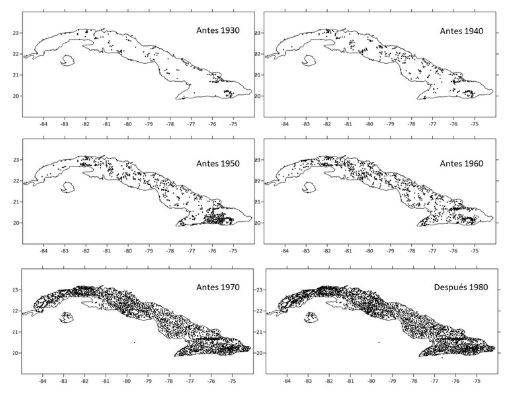Annual and seasonal rainfall in Cuba. Influence of climate indices
Main Article Content
Abstract
In Cuba, periodically, rainfall study have been carried out to prepare isohyietic maps, with which historical reference values have been estimated. For it has used networks with different degrees of spatial and temporal coverage; and the analyzes have been eminently statistical, particularly aimed at completing the data and discussing its quality. In this article, a study is made of the annual rainfall in the 90 years between 1931 and 2020 and on a seasonal scale for the period 1961-2020. The objective is to characterize the annual and seasonal behavior of this variable in Cuba and the western, central and eastern regions, accompanied by the examination of the trends and average values in favorable, neutral or unfavorable scenarios according to the state of the climatic indices ENSO, NAO and the Hurricanes.
Downloads
Article Details

This work is licensed under a Creative Commons Attribution-NonCommercial 4.0 International License.
Those authors who have publications with this journal accept the following terms of the License Attribution-NonCommercial 4.0 International (CC BY-NC 4.0):
You are free to:
- Share — copy and redistribute the material in any medium or format
- Adapt — remix, transform, and build upon the material
The licensor cannot revoke these freedoms as long as you follow the license terms.
Under the following terms:
- Attribution — You must give appropriate credit, provide a link to the license, and indicate if changes were made. You may do so in any reasonable manner, but not in any way that suggests the licensor endorses you or your use.
- NonCommercial — You may not use the material for commercial purposes.
- No additional restrictions — You may not apply legal terms or technological measures that legally restrict others from doing anything the license permits.
The journal is not responsible for the opinions and concepts expressed in the works, they are the sole responsibility of the authors. The Editor, with the assistance of the Editorial Committee, reserves the right to suggest or request advisable or necessary modifications. They are accepted to publish original scientific papers, research results of interest that have not been published or sent to another journal for the same purpose.
The mention of trademarks of equipment, instruments or specific materials is for identification purposes, and there is no promotional commitment in relation to them, neither by the authors nor by the publisher.
References
Campos Aranda. (2023). Temas recientes de análisis de frecuencias hidrológico. Colección investigación. Instituto Mexicano de Tecnología del Agua. ISBN 978-607-8629-27-5. 429 p.
Chamberlin, T. W. (1940). Rainfall maps of Cuba. Monthly Weather Review, 68(1), 4-10. https://journals.ametsoc.org/downloadpdf/view/journals/mwre/68/1/1520-0493_1940_068_0004_rmoc_2_0_co_2.pdf
Fonseca Rivera, C., García Hernández, A., Velázquez Zaldívar, B., de la Maza Santana, D. G., Martínez Álvarez, M., González García, I., Cutié Cancino, V., Vázquez Montenegro, R., Pérez Suárez, R., Mitrani Arenal, I., Hidalgo Mayo, A., Cabrales Infante, J., Leyva Pit, L., & González Fraguela, E. (2024). Estado del Clima en Cuba 2023. Resumen ampliado. Revista Cubana de Meteorología, 30(1). http://rcm.insmet.cu/index.php/rcm/article/view/848
Foscue, E. J. .(1928). Rainfall maps of Cuba. Monthly Weather Review, 56(5), 170-173.
Gagua, G., Zarembo, S., & Izquierdo, A. 1976. Sobre el nuevo mapa isoyético de Cuba. Voluntad Hidráulica, 37, 35-41.
Huerta, J y N. Fernández. (1976). Diseño de la Red Pluviométrica de Cuba. Instituto de Hidroeconomía, La Habana, Cuba.
Izquierdo, A. (1989). En Nuevo Atlas Nacional de Cuba. Instituto de Geografía, Academia de Ciencias de Cuba. ISBN 84-7919-007-4
Jury, M., Malmgren, B. A., y Winter, A. (2007). Subregional precipitation climate of the Caribbean and relationships with ENSO and NAO. Journal of Geophysical Research: Atmospheres, 112(D16). https://agupubs.onlinelibrary.wiley.com/doi/10.1029/2006JD007541
Organización Meteorológica Mundial. (2007). Función de las normales climatológicas en un clima cambiante. OMM DT/No 1377. Ginebra, Suiza. https://library.wmo.int/records/item/59777-funcion-de-las-normales-climatologicas-en-un-clima-cambiante
Organización Meteorológica Mundial. (2017). Directrices de la Organización Meteorológica Mundial sobre el cálculo de las normales climáticas. OMM-N° 1203. Ginebra, Suiza. https://library.wmo.int/viewer/60338?medianame=1203_es_#page=1&viewer=picture&o=bookmark&n=0&q=
Orive Alba, A. (1954). Reconocimiento preliminar de 19 ríos y 2 ciénagas de Cuba. Banco de Fomento Agrícola e Industrial de Cuba, 1954, 156 p.
Planos, E.; O. Barros; A. Carrasco. (2000). En Primera Comunicación Nacional a la Convención Marco de Nciones Unidas sobre Cambio Climático. Citma, 2001.
Rodríguez, F.F. (2005). Mapa Isoyético de Cuba 1960-2000. Memoria técnica del Instituto Nacional de Recursos Hidráulicos.
Trusov I.I, (1967). Las precipitaciones en la isla de Cuba. Instituto Nacional de Recursos Hidráulicos. La Habana. Cuba.
Trusov, I. I., Izquierdo, A., & Díaz, L. R. (1978). Fluctuación de las precipitaciones durante muchos años en Cuba. Revista Ciencia de la Tierra y del Espacio. Editorial de la Academia de Ciencias de Cuba.

